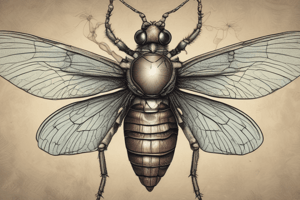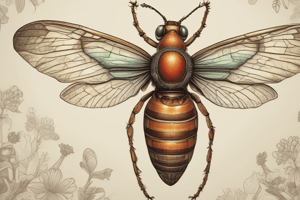Podcast
Questions and Answers
What are the three key components involved in the transmission of vector-borne diseases?
What are the three key components involved in the transmission of vector-borne diseases?
Pathogen, vector, host
How do mosquitoes and ticks contribute to the spread of vector-borne diseases?
How do mosquitoes and ticks contribute to the spread of vector-borne diseases?
By acquiring pathogens from infected hosts and transmitting them to susceptible hosts.
What factors influence the transmission rates of vector-borne diseases?
What factors influence the transmission rates of vector-borne diseases?
Vector abundance, pathogen prevalence, host susceptibility
What are some strategies for the prevention and control of vector-borne diseases?
What are some strategies for the prevention and control of vector-borne diseases?
How does climate change impact the dynamics of vector-borne diseases?
How does climate change impact the dynamics of vector-borne diseases?
What is the main focus of medical entomology?
What is the main focus of medical entomology?
Which arthropods are responsible for transmitting pathogens that cause Lyme Disease?
Which arthropods are responsible for transmitting pathogens that cause Lyme Disease?
Name a bacterial infection transmitted by the black-legged tick.
Name a bacterial infection transmitted by the black-legged tick.
Which mosquito species transmits the West Nile Virus?
Which mosquito species transmits the West Nile Virus?
List two viral infections transmitted by the Aedes species mosquito.
List two viral infections transmitted by the Aedes species mosquito.
Flashcards
Tick-borne diseases
Tick-borne diseases
Illnesses transmitted to humans by ticks, often including bacteria, viruses, or parasites.
Lyme disease
Lyme disease
Bacterial illness caused by Borrelia bacteria, transmitted by black-legged ticks.
Anaplasmosis
Anaplasmosis
Bacterial infection transmitted by black-legged ticks, involving Anaplasma species.
Babesiosis
Babesiosis
Signup and view all the flashcards
Mosquito-borne diseases
Mosquito-borne diseases
Signup and view all the flashcards
West Nile Virus
West Nile Virus
Signup and view all the flashcards
Zika Virus
Zika Virus
Signup and view all the flashcards
Dengue Fever
Dengue Fever
Signup and view all the flashcards
Vector-borne disease
Vector-borne disease
Signup and view all the flashcards
Vector
Vector
Signup and view all the flashcards
Study Notes
Medical Entomology: A Deep Dive into Tick-Borne and Mosquito-Borne Diseases
Medical entomology is a compelling field that combines science, global health, and ecological understanding. This discipline focuses on the relationships between arthropods and human disease, particularly the transmission of pathogens from ticks and mosquitoes.
Tick-Borne Diseases
Ticks are ectoparasites that transmit a variety of pathogens, including bacteria, viruses, and parasites. Some notable diseases include:
- Lyme Disease: A bacterial illness caused by Borrelia bacteria, transmitted by the black-legged tick (Ixodes scapularis) or the Western black-legged tick (Ixodes pacificus).
- Anaplasmosis: A bacterial infection caused by Anaplasma species, transmitted by the black-legged tick (Ixodes scapularis) and the western black-legged tick (Ixodes pacificus).
- Babesiosis: A parasitic infection caused by Babesia species, transmitted by the black-legged tick (Ixodes scapularis) and the western black-legged tick (Ixodes pacificus).
Mosquito-Borne Diseases
Mosquitoes are the vectors responsible for transmitting a wide range of diseases, including:
- West Nile Virus: A viral infection transmitted by the Culex species mosquito.
- Zika Virus: A viral infection transmitted by the Aedes species mosquito.
- Dengue Fever: A viral infection transmitted by the Aedes species mosquito.
Vector-Borne Disease Transmission
Vector-borne diseases result from the interaction between a pathogen, a vector, and a host. Ticks and mosquitoes are the most common vectors, acquiring pathogens from infected hosts and transmitting them to susceptible hosts. Factors affecting transmission rates include vector abundance, pathogen prevalence, and host susceptibility.
Disease Control and Prevention
Prevention and control of vector-borne diseases involve various strategies, including vector surveillance, environmental management, and personal protection measures. Surveillance aims to monitor vector populations and their distribution, while environmental management focuses on reducing breeding sites and modifying habitats to decrease vector abundance. Personal protection measures include using insect repellents, wearing protective clothing, and avoiding outdoor activities during peak biting times.
The Impact of Climate Change
Climate change has a significant influence on vector-borne diseases. Warmer temperatures, changing precipitation patterns, and habitat changes contribute to increased vector abundance, expanded geographic range, and altered transmission dynamics. These changes highlight the need for ongoing research and adaptation in vector control strategies.
In conclusion, medical entomology offers valuable insights into the relationships between arthropods and human disease. The understanding of tick-borne and mosquito-borne diseases, transmission dynamics, and control strategies is crucial to protecting public health and combating the growing burden of vector-borne diseases.
Studying That Suits You
Use AI to generate personalized quizzes and flashcards to suit your learning preferences.




